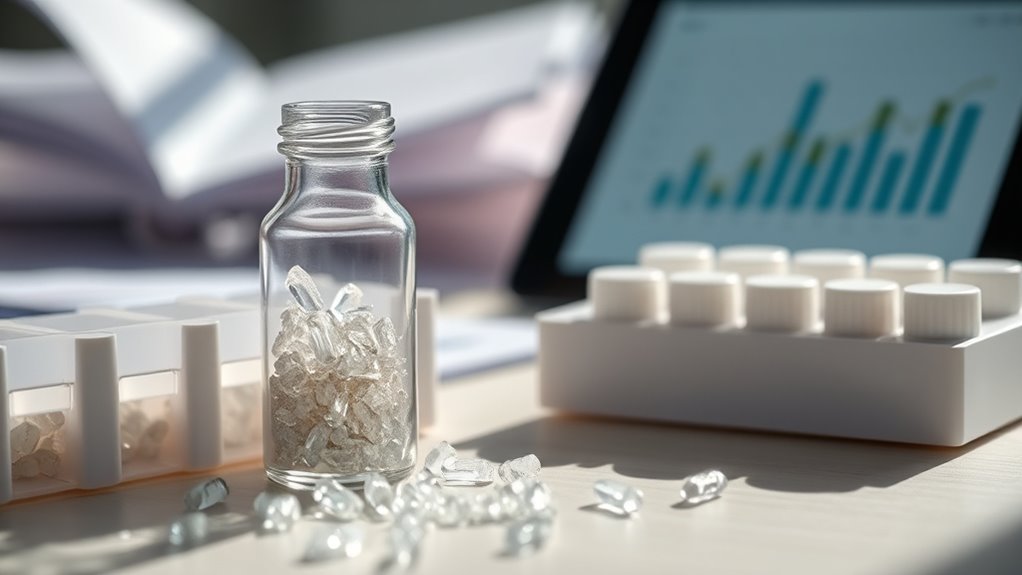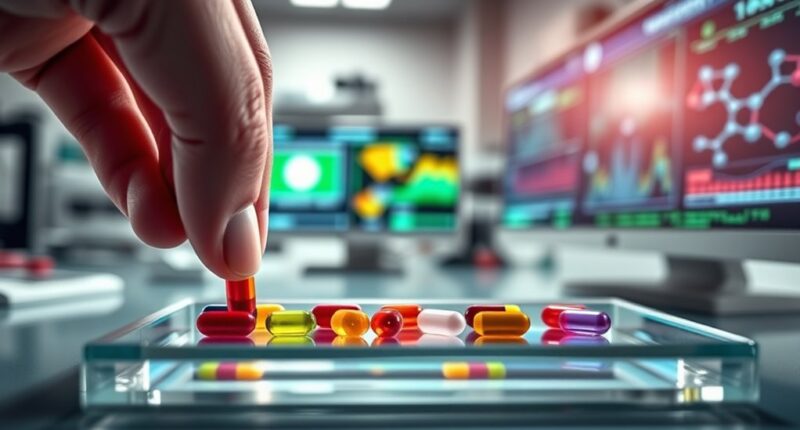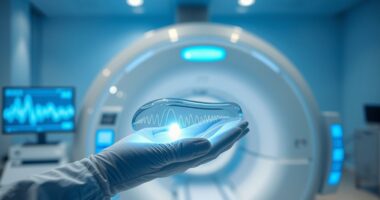Scientists are exploring micro-dosing psychedelics like LSD and psilocybin as a way to help ease depression by taking very small doses that boost brain plasticity without causing hallucinations. These tiny amounts are believed to recalibrate neural circuits and enhance emotional resilience, offering potential mood improvements. While research is still ongoing, understanding how these doses work can open new avenues for mental health treatments—if you want to see how this approach is developing, keep exploring further.
Key Takeaways
- Researchers are investigating micro-dosing psychedelics like LSD and psilocybin to assess their potential in alleviating depression symptoms.
- Studies focus on small doses that enhance brain plasticity and neural connectivity without causing hallucinations.
- Clinical trials explore dosing schedules and safety protocols to maximize therapeutic benefits while minimizing risks.
- Micro-dosing aims to improve mood and emotional resilience by recalibrating dysregulated brain circuits associated with depression.
- Ongoing research seeks to establish standardized guidelines and understand long-term effects for depression treatment.

In recent years, micro-dosing psychedelics has emerged as a promising approach for managing depression, capturing the attention of researchers and mental health professionals alike. This method involves taking very small amounts of substances like LSD or psilocybin, enough to produce subtle effects without hallucinations or intense perceptual changes. The focus is on harnessing the potential therapeutic applications of these tiny doses to improve mood, increase emotional resilience, and reduce symptoms of depression. As interest grows, so does the need for clear dosage guidelines to ensure safety and maximize benefits.
You might wonder how such a low dose can have a meaningful impact. The key lies in the way psychedelics influence brain plasticity, mood regulation, and neural connectivity. When used correctly, micro-dosing may help recalibrate brain circuits that are often dysregulated in depression. However, because psychedelics are potent compounds, understanding the proper dosage guidelines is critical. Researchers recommend starting with doses as low as 1/10th to 1/20th of a recreational dose, typically around 10-20 micrograms of LSD or 0.1 to 0.3 grams of dried psilocybin mushrooms. These doses are small enough to avoid hallucinations, yet sufficient to potentially produce therapeutic effects.
You should be cautious about the dosage guidelines, as individual responses can vary substantially. Factors such as body weight, metabolism, and mental health history influence how you might react to micro-dosing. Many studies suggest following a structured schedule, such as dosing every three or four days, to monitor effects and prevent tolerance buildup. It’s also essential to keep track of your mood, energy levels, and any side effects during this process. While some preliminary research indicates promising results, it’s important to remember that micro-dosing is still experimental, and standardized protocols aren’t yet universally established. Furthermore, understanding brain plasticity is crucial to appreciating how these small doses may support mood improvements.
In the context of therapeutic applications, micro-dosing could complement traditional treatments like therapy or medication, offering a new avenue for those resistant to conventional approaches. Still, it’s crucial to consult with healthcare professionals before starting any micro-dosing regimen. They can help tailor the dosage guidelines to your specific needs and ensure safe practices. As research continues, clearer guidelines and safety protocols are expected to emerge, making micro-dosing a more dependable and accessible option for depression management. For now, understanding the importance of precise dosing and cautious application is your best strategy to explore its potential benefits responsibly.
Frequently Asked Questions
What Are the Long-Term Effects of Micro-Dosing Psychedelics?
You wonder about the long-term safety and neuroplasticity effects of micro-dosing psychedelics. While research is still emerging, some studies suggest it may enhance neuroplasticity, potentially offering mental health benefits. However, long-term effects remain unclear, and risks like dependence or cognitive changes are possible. it is crucial to approach micro-dosing carefully, stay informed about new findings, and consult healthcare professionals before trying it regularly.
How Do Different Psychedelics Compare in Treating Depression?
Imagine comparing different psychedelics like comparing stars in the night sky—you’ll notice varying levels of psychedelic potency and effects. When treating depression, you need consistent dosage to guarantee safety and efficacy. Psilocybin often shows promising results, while LSD’s higher potency demands careful control. Each psychedelic’s unique profile influences how it helps with depression, so understanding these differences allows you to select the right option for your mental health journey.
Are There Specific Populations That Benefit Most From Micro-Dosing?
You might find that vulnerable populations, such as those with treatment-resistant depression or certain mental health conditions, benefit most from micro-dosing. Research suggests these groups often experience notable improvements in mood and resilience. If you’re considering micro-dosing, it is crucial to consult healthcare professionals, as individual responses vary. While promising, ongoing studies aim to better understand which populations gain the most and how to optimize safety and effectiveness.
What Are the Legal Considerations Surrounding Micro-Dosing?
When you consider micro-dosing, you need to understand the legal frameworks and regulatory challenges involved. Laws vary widely across regions, and many psychedelics remain illegal, posing risks if you don’t follow local regulations. You should stay informed about current laws and possible changes, as enforcement can be strict. Ignoring these legal considerations can lead to serious consequences, so always research and consult legal experts before experimenting with micro-dosing.
How Accessible Are Micro-Dosing Treatments Outside Clinical Trials?
You might find micro-dosing treatments somewhat accessible outside clinical trials, but accessibility challenges remain. Legal restrictions and lack of regulation limit widespread availability, pushing many to seek alternative therapies. While some underground markets offer options, they come with risks. If you’re considering micro-dosing, research thoroughly and consult a healthcare professional to navigate these barriers safely and effectively, understanding the legal landscape and potential risks involved.
Conclusion
As research reveals, micro-dosing may mark a meaningful milestone in mental health medicine. While scientists study its subtle, sustained effects, remember to remain cautious and curious. Embrace the evolving exploration, but prioritize proper guidance and patience. Micro-dosing’s potential promises progress, but it’s your persistence that truly paves the path to peace. Stay steady, stay informed, and let curiosity cultivate your courage on this promising, pioneering journey toward mental well-being.










